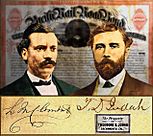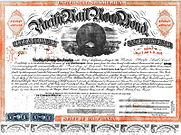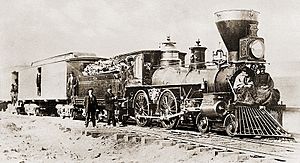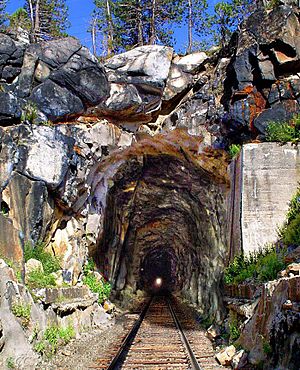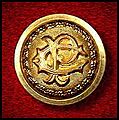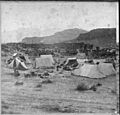Central Pacific Railroad facts for kids
The Central Pacific Railroad (CPRR) was a railroad company that helped build the first Transcontinental Railroad across North America. It was started in 1861 and officially approved by the U.S. Congress in 1862. The company's main job was to build the railroad east from Sacramento, California, connecting the western part of the country.
The idea for a railroad across the country had been discussed for a while, but political disagreements, especially about slavery, stopped it. When the southern states left the U.S. in 1861, the Republican Party gained more control in Congress. They quickly passed laws in 1862 to allow the railroad to be built. The government helped pay for it by giving land and special bonds (like loans) to the railroad companies. This project was important for moving mail, troops, and supplies quickly and safely across the country.
 |
|

Route of the First transcontinental railroad with the Central Pacific portion in red
|
|
| Overview | |
|---|---|
| Headquarters | Sacramento, CA; San Francisco, California |
| Locale | Sacramento, California-Ogden, Utah |
| Dates of operation | June 28, 1861–April 1, 1885 continued as an SP leased line until June 30, 1959 |
| Successor | Southern Pacific |
| Technical | |
| Track gauge | 4 ft 8 1⁄2 in (1,435 mm) standard gauge |
Contents
Building the Railroad
Starting the Project
In 1860, a surveyor named Charles Marsh met with Theodore Judah, an engineer who had built other railroads. They explored the Sierra Nevada Mountains and realized that building a railroad across them was possible.
In early 1861, Marsh, Judah, and another man named Daniel Strong met with four important businessmen: Collis P. Huntington, Leland Stanford, Mark Hopkins Jr., and Charles Crocker. These five men, along with Lucius Anson Booth, became the first leaders of the Central Pacific Railroad. They were often called "The Big Four."
Construction Begins

The U.S. Congress passed the Pacific Railway Act in 1862. This law gave the Central Pacific Railroad government bonds and land for every mile of track they built. Leland Stanford became the company's president, while Huntington handled money and buying supplies. Hopkins was the treasurer, and Crocker was in charge of the actual construction.
Building the railroad officially started in 1863 in Sacramento. The real work picked up in 1865 when Charles Crocker suggested hiring Chinese immigrant workers.

By 1868, about 12,000 Chinese laborers were working on the railroad. They made up 80% of the construction team. They faced very tough conditions, especially when building through the Donner Pass in the Sierra Nevada mountains. This involved digging many tunnels through hard rock. The Chinese workers were crucial to the railroad's success.
Connecting the Coasts
On May 10, 1869, the Central Pacific Railroad tracks met the Union Pacific Railroad tracks at Promontory, Utah. This historic event was marked by the driving of the "Golden spike". After this, people could travel across the country by train in about eight days. Before, it took months by ship or dangerous wagon journeys.
In 1885, the Central Pacific Railroad was taken over by the Southern Pacific Company. It officially became part of Southern Pacific in 1959. Today, the original route is controlled by the Union Pacific, which bought Southern Pacific in 1996.
Train Engines (Locomotives)
The Central Pacific's first train engines were mostly a type called "4-4-0". It was hard to get engines from factories in the eastern U.S. because of the American Civil War. So, the engines had to be taken apart, shipped by boat all the way around Cape Horn (the southern tip of South America), and then put back together in Sacramento. This long journey took about four months!
The railroad bought engines from many different companies. Later, in the 1870s, the Central Pacific started building and rebuilding its own engines in Sacramento. Many of the older engines had names, but later, they decided to just use numbers. One engine built in the 1880s did get a name: the El Gobernador.
Preserved Locomotives
Some Central Pacific engines have been saved and can be seen today:

- Central Pacific 1, Gov. Stanford
- CP 233, a "2-6-2T" type, is at the California State Railroad Museum.
- Central Pacific 3, C. P. Huntington, which was later bought by the Southern Pacific.
- The former Western Pacific Mariposa (Central Pacific's second number 31) is at the Travel Town Museum in Los Angeles.
- The Virginia and Truckee 18 Dayton was built by the Central Pacific's shops and shows what their engines were like.
- Exact working copies of Central Pacific's numbers 60 Jupiter and 63 Leviathan have been built. The Jupiter is at the Golden Spike National Historic Site. The Leviathan travels to different railroads.
Timeline of Important Events
1861
- June 28: The "Central Pacific Rail Road of California" company is officially started.
1862
- July 1: President Abraham Lincoln signs the Pacific Railway Act, allowing the Central Pacific and Union Pacific to build the Transcontinental Railroad.
1863
- January 8: Ground is broken (construction officially begins) in Sacramento, California.
- October 26: The first rail of the Pacific Railroad is laid in Sacramento.
1864
- June 3: The first train carrying paying passengers runs between Sacramento and Newcastle, California.
1865
- February: Central Pacific hires its first 50 Chinese immigrant workers.
- September 1: The railroad reaches Colfax, California.
1867
- June 25: About 5,000 Chinese railroad workers go on strike to protest long hours and unfair pay.
- August 28: The difficult "Summit Tunnel" (Tunnel No. 6) through the Sierra Nevada mountains is finished. This was a huge challenge for the mainly Chinese crew.
1868
- June 18: The first passenger train crosses the Sierra Nevada to Reno, Nevada.
1869
- April 28: Central Pacific track crews lay 10 miles (16 km) of track in one day, a record that still stands!
- May 10: The Central Pacific and Union Pacific tracks meet at Promontory, Utah, completing the Transcontinental Railroad.
- September 6: The first train from coast-to-coast reaches the San Francisco Bay at Alameda Terminal.
1885
- April 1: Central Pacific is leased (rented and operated) by the Southern Pacific.
1959
- June 30: Central Pacific officially becomes part of the Southern Pacific.
Museums and Archives
You can see a copy of the original Central Pacific Railroad passenger station at the California State Railroad Museum in Old Sacramento State Historic Park.
Many of the company's old letters and documents are kept at Syracuse University. Alfred A. Hart was the official photographer who took pictures during the construction of the CPRR.
Images for kids
-
The Central Pacific built trestles (wooden bridges) to build the railroad faster. This one is near Secret Town, California. Photo: Carleton Watkins
-
The Last Spike, painting by Thomas Hill (1881).
See also
 In Spanish: Central Pacific para niños
In Spanish: Central Pacific para niños
- Rail transport in California
- Donner Pass (Sierra Nevada)


